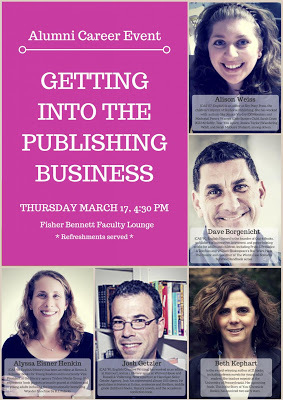Beth Kephart's Blog, page 25
March 13, 2016
the week ahead, and thoughts on Francisco X. Stork, Luanne Rice, Carolyn Mackler, and David Levithan
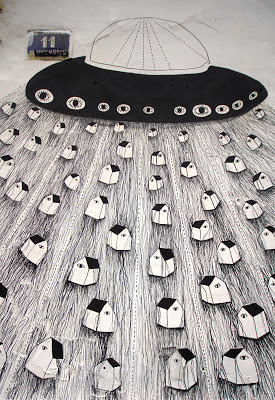 You know how, when the fever finally breaks, you emerge new (again) to the world? These past many days, fighting the flu that has afflicted so many, fighting the political news that is equally afflicting, I have been preparing for the week ahead—losing myself inside a heated fog, waking with urgency, getting out into the world, then rushing back home to my couch and its furry cover, where, again, I try to prepare—shrugging off the fever, then succumbing to it.
You know how, when the fever finally breaks, you emerge new (again) to the world? These past many days, fighting the flu that has afflicted so many, fighting the political news that is equally afflicting, I have been preparing for the week ahead—losing myself inside a heated fog, waking with urgency, getting out into the world, then rushing back home to my couch and its furry cover, where, again, I try to prepare—shrugging off the fever, then succumbing to it. This week: The first workshopping of memoirs in my class at Penn, on Tuesday. A talk about Philadelphia stories at the Union League, on Wednesday. The alumni publishing event, at Penn, on Thursday. The NYCTAF panel, "Perspectives," featuring Carolyn Mackler, Luanne Rice, Francisco X. Stork, myself, and moderator David Levithan, on Friday at the New York Public Library (South Court), at 4:40. My first signing of This Is the Story of You at Books of Wonder on Sunday, at 2:30 (alongside many other wonderful writers).
(For more on any of these events, or additional events, including the upcoming keynote for the annual Historic Rittenhousetown fundraiser, see the sidebar on this page.)
The only way I know how to prepare for a panel is to read the work of my fellow panelists. And so I have. I began with The Memory of Light, Stork's moving meditation on depression and mental unwellness. This is the story of Vicky, a second-best sort of sister mourning the death of her mother who no longer wishes to live and whose suicide attempt fails. Rushed to a hospital, Vicky becomes friends with others her age who are also battling demons. Vicky needs a reason to believe that her life is worth living. She doubts that it is for long stretches of this book. But as her new friends spiral into unsettling places—and as they reveal their own humanity—something shifts.
Stork, whose Marcelo in the Real World is a book that also must be read, writes from a true place, a deep understanding of a condition, depression that, while it affects so many, remains so poorly understood: "You are not the clouds or even the blue sky where clouds live," Vicky is told. "You are the sun behind them, giving light to all, and the sun is made up of goodness and kindness and life."
With The Secret Language of Sisters, Luanne Rice, a bestselling adult novelist (whose work has often been translated to TV), presents her YA debut—the story of two sisters whose lives are irrevocably changed by a texting-when-driving accident. Roo, a photographer, hopes to be headed to Yale. Tilly, the younger sister, is envious/proud of Roo's abilities and grace. The accident that results from Roo's response to Tilly's text leaves Roo with locked-in syndrome—the same terrifying condition that lies at the heart of Jean Dominique-Bauby's memoir, The Diving Bell and the Butterfly. As the novel unfolds, the two sisters speak to us—yes, both sisters, despite the fact that no one (but us) can hear Roo's thoughts for the longest time.
I remembered my seizure, Tilly standing there—the worst feeling I've ever had, thrashing around with no control, hearing her scream just before I passed out. I woke up being restrained—or at least that's what I thought. I thought they had tied me down. Then I realized, No, there are no straps. It's me—I can't move. I can't speak. I can't get anyone to hear me.Rice has created a story of triumphal love despite harrowing circumstances.
Then there is the beloved Carolyn Mackler, author of The Earth, My Butt, and Other Big Round Things (a Printz honor book), The Future of Us (co-authored with Jay Asher), and others. In her new book, Infinite in Between, Mackler traces the intertwined lives of five high school students who survive freshman orientation and step (sometimes sideways, sometimes backwards, but finally ahead) toward graduation—five likable teens whose differences bind them.
Of the five, Zoe, the daughter of a celebrity now in rehab, is the most (ruefully) famous. We first meet her when she learns that her mother has (without saying goodbye) left their Colorado home. Zoe's life is about to change:
Zoe bit at her thumbnail. She knew things were getting worse with her mom, but it wasn't like anyone was talking about it. It wasn't like anyone ever talked about anything.Finally, there is David Levithan himself, who, with all his charisma and intelligence, constructs New York City Teen Author Festival—a mammoth undertaking involving more than a dozen venues and 110 authors. Every day, including today, at the Strand, there are events. David is behind each one. We're so grateful to him for opening these doors, and I'm grateful that he'll be moderating our panel—bringing his insights as an editor and his great talents as a writer.
"What?" she asked, her voice rising.
Rosa touched her arm. Their housekeeper was on the older side and had a granddaughter around Zoe's age she sometimes brought over.
"I know it's not fair," Rosa said, "but you can try to make the best of it."
"Where is Hankinson, anyway?"
"It's in New York State. Your aunt lives there. That's nice, right? You're going to stay with her for a while."




Published on March 13, 2016 07:02
March 10, 2016
Juncture Workshops—learn more about our September gathering on a farm
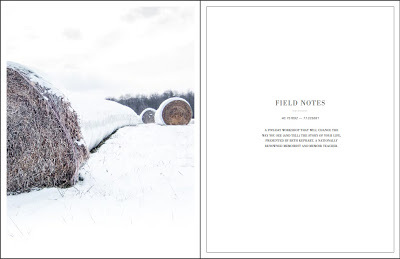 We've been so blessed by the response to our announcement regarding the launch of Juncture Workshops, our series of memoir workshops.
We've been so blessed by the response to our announcement regarding the launch of Juncture Workshops, our series of memoir workshops.Recently we put together an informational brochure for those who think that the inaugural workshop—which is taking place from September 11 - September 16 on a farm in McClure, PA— might be just right for them.
Interested? Please contact us through the Juncture Workshops web site, and we'll send a PDF your way.




Published on March 10, 2016 04:56
March 9, 2016
LOVE at the Philadelphia International Airport, a six-month exhibition now up in Terminal D
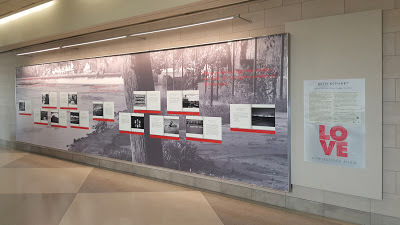
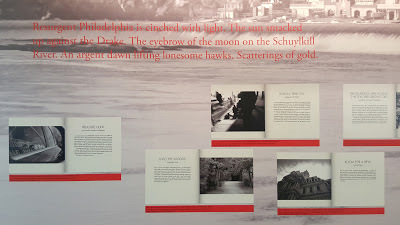
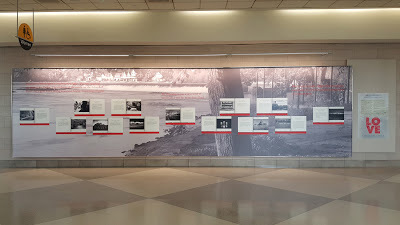
For the past many months, Leah Douglas and Ursula Stuby have been working with their incredible team to bring my LOVE: A Philadelphia Affair photographs and thoughts to life at the Philadelphia International Airport.
Today they unveiled the exhibition. It is up. It is real.
An exhibition like this one stills the whirligig thoughts that haunt me. It makes me stop, pause, be grateful for all the wanderings and ponderings that have led me here.
The exhibit is located in Terminal D, accessible by ticketed passengers and presented by the Exhibitions Program at the Philadelphia International Airport. It will be up through the Democratic Convention—its own brand of welcome committee to those who travel to and from our city.
I am, and always will be, grateful.
If you are en route and happening by, this wall would love to greet you.




Published on March 09, 2016 03:21
March 6, 2016
This Is the Story of You: a scene from my Jersey Shore novel
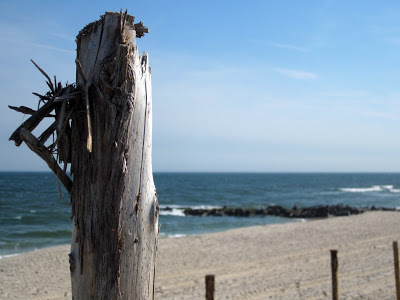 In less than five weeks, This Is the Story of You, my Jersey Shore novel, will be released by Chronicle Books. A Junior Library Guild selection that has received two early stars, this is a mystery set in the wake of a monster storm. It's a meditation on our environment and an exploration of friendship, sisterhood, loss, and resilience.
In less than five weeks, This Is the Story of You, my Jersey Shore novel, will be released by Chronicle Books. A Junior Library Guild selection that has received two early stars, this is a mystery set in the wake of a monster storm. It's a meditation on our environment and an exploration of friendship, sisterhood, loss, and resilience.It is, perhaps, the most urgent novel I've yet written, both in terms of themes and pacing.
On March 18, in the New York Public Library, as part of the New York City Teen Author Festival, I'll be reading from the book and talking about the perspective adults bring to the novels they write about teens in a panel gorgeously assembled by David Levithan and featuring Carolyn Mackler, Luanne Rice, and Francisco Stork. On March 20, I'll be signing early copies at New York City's iconic Books of Wonder. And on April 30, at Main Point Books in Bryn Mawr, PA, I'll be doing a signing.
This morning I'm sharing this scene.
Here I should probably explain the rules, the lines in the sand, the ins and outs of Haven. We were a people shaped by extremes. Too much and too little were in our genes.
To be specific:
Too little was the size of things—the dimension of our island, the we-fit-inside-it-bank-turned-school, the quality of restaurants, the quantity of bridges.
Too much was The Season—Memorial Day through Labor Day. Vacationeers by the boatload, bikinis by the square inch, coolers by the mile, a puke-able waft of SPFs. The longest lines at night were at Dippy’s Icy Creams.
The longest lines by day circled the lighthouse. During The Season the public trash bins were volcanic eruptions, the songbirds were scarce, the deer hid where you couldn’t find them, the hamburgers were priced like mini filets mignons, and the rentable bikes streamed up, streamed down. At the Mini Amuse the Giant Wheel turned, the Alice in Wonderland teased, the dozen giraffes on the merry-go-round looked demoralized and beat. At Dusker’s Five and Dime the hermit crabs in the painted shells sold for exorbitant fees.
Whoever was up there in the little planes that dragged the advertising banners around would have looked down and seen the flopped hats, crusted towels, tippy shovels, broken castles, and bands of Frisbee fliers—Vacationeers, each one. Whoever was up there looking down would not have seen the bona fides, the Year-Rounders, the us, because we weren’t on the beach. We were too employed renting out the bikes, flipping the burgers, scooping the Dippy’s, cranking up the carousel, veering the Vacationeers out of riptides—to get out and be seen. From the age of very young we had been taught to maximize The Season, which was code for keeping the minimum wage coming, which was another way of saying that we stepped out of the way, we subserved, for the three hot months of summer.
We Year-Rounders had been babies together, toddlers together, kindergartners together, Alabasterans. We had a pact: Let the infiltrators be and watch them leave and don’t divide to conquer. We knew that what mattered most of all was us, and that we’d be there for us, and that we would not allow the outside world to actually dilute us. Like I said,we knew our water.
Six miles long.
One-half mile wide. Haven.
Go forth and conquer together.




Published on March 06, 2016 03:55
March 4, 2016
In the Inky: The Red Pants Project—Celebrating the People in our Lives (in honor of Mike and Chris Yasick and on behalf of VEDS)
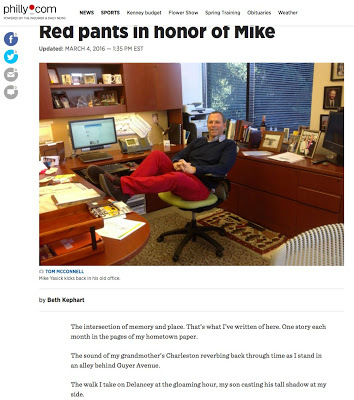 In honor of our friend Mike Yasick, his son, Chris, their entire family, and those who have been diagnosed with a rare and crushing disease known as VEDS, I write today in the Philadelphia Inquirer of the launch of Red Pants Project, which asks each of to take a moment to celebrate the people in our lives.
In honor of our friend Mike Yasick, his son, Chris, their entire family, and those who have been diagnosed with a rare and crushing disease known as VEDS, I write today in the Philadelphia Inquirer of the launch of Red Pants Project, which asks each of to take a moment to celebrate the people in our lives.The story is here.




Published on March 04, 2016 11:08
In the Inky: The Red Pants Project—Celebrating the People In Our Lives (In honor of Mike and Chris Yasick and on behalf of VEDS)
 In honor of our friend Mike Yasick, his son Chris, their entire family, and those who have been diagnosed with a rare and crushing disease known as VEDS, I write today in the Philadelphia Inquirer of the launch of Red Pants Project, which asks each of to take a moment to celebrate the people in our lives.
In honor of our friend Mike Yasick, his son Chris, their entire family, and those who have been diagnosed with a rare and crushing disease known as VEDS, I write today in the Philadelphia Inquirer of the launch of Red Pants Project, which asks each of to take a moment to celebrate the people in our lives.The story is here.




Published on March 04, 2016 11:08
Getting into the Publishing Business: Penn Alumni Career Event
Published on March 04, 2016 06:07
March 3, 2016
In Chicago Tribune: When Breath Becomes Air/Paul Kalanithi
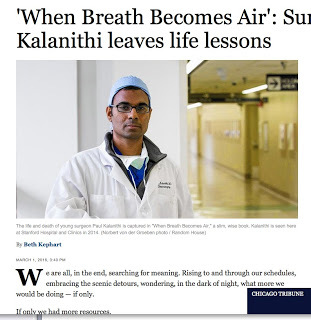 When Paul Kalanithi, a rising neurosurgeon, learned his life would be abbreviated just as the most exquisite part was then beginning, he turned to the page to tell his story.
When Paul Kalanithi, a rising neurosurgeon, learned his life would be abbreviated just as the most exquisite part was then beginning, he turned to the page to tell his story.My thoughts on that book are here, in the Chicago Tribune.




Published on March 03, 2016 05:16
March 2, 2016
Fifteen minutes on home—a peace-yielding soundtrack for a raucous world
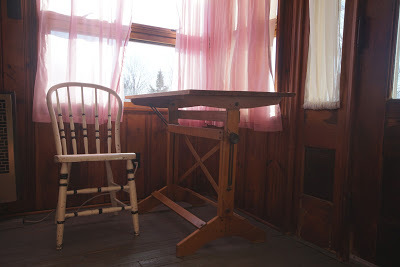 Last night, at the Kelly Writers House, we thought about home—a theme that has carried my current class of memoirists forward. We were graced by the presence of the exquisite memoirist/novelist Rahna Reiko Rizzuto, the young adult novelist super star A.S. King, and the all-round talent (fiction, young adult fiction, New York Times/Slate style commentator) Margo Rabb. We were joined by Penn faculty, my current students, my previous students, and friends. Jessica Lowenthal facilitated every last detail. Jamie-Lee Josselyn brought her ineffable spirit. Al Filreis sat among us, in the home that he has built. Julia Bloch was the woman we all love, and, Julia, I'll be forever grateful for your words.
Last night, at the Kelly Writers House, we thought about home—a theme that has carried my current class of memoirists forward. We were graced by the presence of the exquisite memoirist/novelist Rahna Reiko Rizzuto, the young adult novelist super star A.S. King, and the all-round talent (fiction, young adult fiction, New York Times/Slate style commentator) Margo Rabb. We were joined by Penn faculty, my current students, my previous students, and friends. Jessica Lowenthal facilitated every last detail. Jamie-Lee Josselyn brought her ineffable spirit. Al Filreis sat among us, in the home that he has built. Julia Bloch was the woman we all love, and, Julia, I'll be forever grateful for your words.The evening was made possible by the generous gift of the Beltrans, whose endowment causes all of us who teach writing at Penn to think even harder about how we hope on behalf of our students.
We closed the evening by dimming the lights and listening to the voices of students and faculty as they answered the simple, confounding question, What is home? This is a gloriously produced soundtrack (thank you, Wexler Studio's Zach and Adelaide), made even more stunning by the guitar work of our own music man (and someday Grammy winner), Cole Bauer.
I encourage you to listen (here). In a fractured world, these words offer light.
For even more writing and thinking about home, I encourage you to stop by the Writers House and pick up your copy of our Beltran chapbook, Where You Live & What You Love.




Published on March 02, 2016 05:44
February 28, 2016
Burning Down the House/Jane Mendelsohn: Reflections
 Long before the current unkempt presidential election season was set into play, the novelist Jane Mendelsohn (I Was Amelia Earhart) was embarked on her fourth novel, the story of a New York City family whose wealth is the product of intense (even monstrous) real estate dealing.
Long before the current unkempt presidential election season was set into play, the novelist Jane Mendelsohn (I Was Amelia Earhart) was embarked on her fourth novel, the story of a New York City family whose wealth is the product of intense (even monstrous) real estate dealing.The family patriarch is Steve Zane. His "... office towers, malls, skyscrapers, housing developments, business contacts, political connections" have yielded tremendous, soul-darkening privilege. They have set decay—often violent decay—into motion, against the backdrop of sizable luxury.
Everything is in jeopardy in Burning Down the House (Alfred A. Knopf, March 31, 2016). The scheming son has had it with the father. The adopted child is self destructing. The Eastern European nanny who has emerged from a terrifying kidnapping and years as a sex slave is asked to revisit the terrors of her past. People are disposable. And when Zane—now older, now reflective, now negotiating the tenderness of unexpected affection—seeks at last to draw a moral line, it may (or may not) be too late.
Fearlessly deploying past and present tenses, multiple perspectives, and the smack of white space, Mendelsohn creates a harshly glinting (a Mendelsohn word) milieu.
Here is Steve Zane himself, for example, on the savages now destroying our world.
What we are confronted with in today's world are cruel degenerate people with no sensitivity or psychological awareness. Savages with no feelings. Maybe it's always been this way, but it's worse now. They are in charge. We are talking about people who are so numb to their fellow human beings that they think they know better how everybody should live. And do you know what happens to people who know what's best for everybody? They destroy the world. That's what they do. They dismember and disembowel the individual and boil her flesh and entrails down in a stew with everybody else.Here a character elucidates artistic ambition, envy, and ego:
They'd followed his successful career as if they were bird-watchers and he some common pigeon who had inexplicably been accepted by a flock of rare eagles. They no more believed in his talent than they believed that they themselves might be untalented. Over the years they had won prizes and fellowships and commissions and professorships. They had been invited to lecture and appeared in numerous footnotes. These achievements had been like snakebites on their egos, swelling them out of proportion to the rest of their beings so that their sense of importance bulged and tottered on top of them like extra heads, as if they were monsters in a fable, muzzled, drooling, snouted, skin split to reveal pink bone and yellow ooze.Like Lidia Yuknavitch, Mendelsohn brings a rare poetic sensibility to indecorous circumstances, a loveliness of language to odious characters. There's no hedging of any bets here, no softening of the tale, no hitching of this plot to a book-club formula. Obscene wealth and uncured ambition are often ruinous combustibles. Mendelsohn, in Burning Down the House, will not pretend that they aren't.




Published on February 28, 2016 14:57

